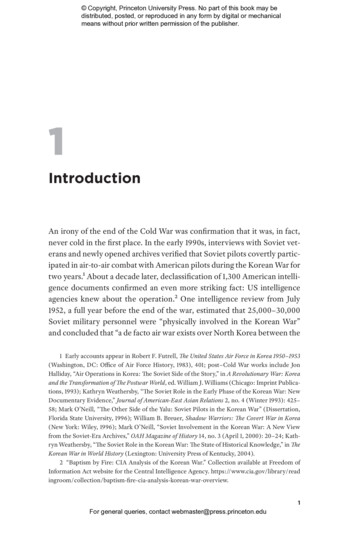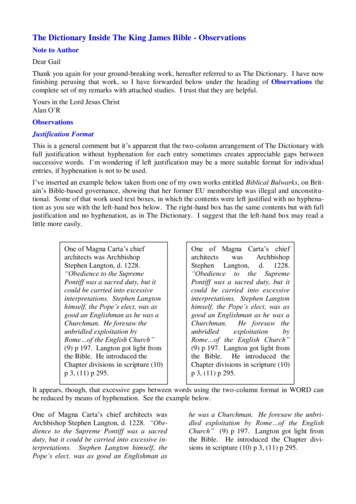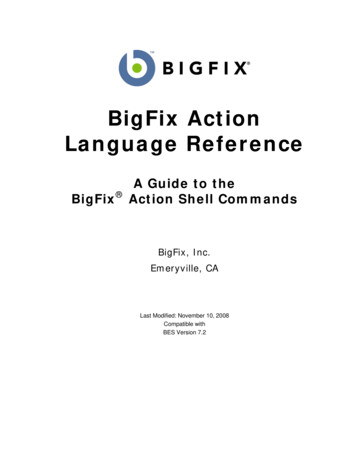
Transcription
Covert Action and Clandestine Activities ofthe Intelligence Community: SelectedDefinitions in BriefMichael E. DeVineAnalyst in Intelligence and National SecurityUpdated June 14, 2019Congressional Research Service7-5700www.crs.govR45175
SUMMARYCovert Action and Clandestine Activities of theIntelligence Community: SelectedDefinitions in BriefThis report provides background and definitions for covert action and clandestine activitiescarried out by the Intelligence Community (IC) and military. Congress has defined several ofthese terms in statute; others appear only in committee reports. Still others are military terms.These definitions describe activities that support U.S. national security policy, and are, therefore,important to Congress’s intelligence and defense oversight responsibilities.R45175June 14, 2019Michael E. DeVineAnalyst in Intelligence andNational Securitymedevine@crs.loc.govFor a copy of the full report,please call 7-5700 or visitwww.crs.gov.Confusion over the proper jurisdiction for congressional oversight can occur when covert action or clandestine intelligenceactivities appear similar to certain military operations that may employ clandestine methodology or have objectives similar tothose for covert action. Intelligence and military matters fall under different authorities of the U.S. Code, and have, as aresult, different statutory requirements for providing notification to Congress. Applicable statutes that govern intelligenceactivities under Title 50 of the U.S. Code emphasize prior notification to the congressional intelligence committees for eachseparate activity. Under its Title 10 U.S. Code authorities, however, the Department of Defense generally providesnotification of certain types of secret or clandestine military operations to the Armed Services committees after theircommencement, often by briefing Congress as part of a larger, supported military operation or campaign.The IC, for example, in conducting a covert action, must generally provide prior notification to the congressional intelligencecommittees by means of a presidential finding describing plans to have an intelligence operation influence political, military,or economic conditions abroad while concealing U.S. sponsorship. The military, on the other hand, under Title 10, has theimplicit authority to conduct operations that resemble covert action, but that DOD classifies as operational preparation of theenvironment (OPE). OPE is handled differently for oversight purposes, despite sharing with covert action a number ofcharacteristics that heighten Congress’s interest: a serious risk of exposure, compromise of information, loss of life, and apossible requirement to conceal U.S. sponsorship.An understanding of how these terms are used can help Congress navigate potential challenges in conducting oversight. Thisreport is the first of three reports on covert action and clandestine activities of the IC. The second, CRS Report R45191,Covert Action and Clandestine Activities of the Intelligence Community: Selected Notification Requirements in Brief, byMichael E. DeVine, describes the different statutory requirements for keeping Congress informed of these activities. Thethird, CRS Report R45196, Covert Action and Clandestine Activities of the Intelligence Community: Framework forCongressional Oversight In Brief, by Michael E. DeVine, is intended to assist Congress in assessing the premises justifyingcovert action and clandestine activities, their impact on national security, operational viability, funding requirements, andpossible long-term or unintended consequences.Congressional Research Service
Covert Action and Clandestine Activities of the Intelligence CommunityContentsIntroduction . 1Background . 1Defining Title 10 and Title 50 Authorities . 3Selected Terms, Definitions, and Descriptions . 4Covert Action . 4Clandestine Activities. 5Traditional Military Activities and Routine Support . 6Other-than-Routine Support . 7Operational Preparation of the Environment . 7Sensitive Military Operations . 9Sensitive Military Cyber Operations . 9ContactsAuthor Contact Information . 10Congressional Research Service
Covert Action and Clandestine Activities of the Intelligence CommunityIntroductionCongressional oversight of the intelligence community (IC) 1 enables Members to gain insight intoand offer advice on programs and activities that can significantly influence U.S. foreign policyand its outcomes. This In Brief addresses Congress’s ongoing interest in oversight of covertaction and clandestine activities.The distinction between government agency activities described as covert and clandestine can beconfusing. Which agencies are authorized to conduct covert action and clandestine activities?What are their legal authorities for doing so? Which military terms describe activities that mightseem similar but are distinct from covert action?Covert action is codified as an activity or activities of the United States Government to influencepolitical, economic, or military conditions abroad, where it is intended that the role of the UnitedStates will not be apparent or acknowledged publicly. Covert operations are “planned andexecuted as to conceal the identity of or permit plausible denial by the sponsor.”2While not defined by statute, DOD doctrine describes clandestine activities as “operationssponsored or conducted by governmental departments or agencies in such a way as to assuresecrecy or concealment” that may include relatively passive intelligence collection informationgathering operations.3 Unlike covert action, clandestine activities do not require prior notice toCongress via a presidential finding, but may still require notification of Congress. This definitiondifferentiates clandestine from covert, using clandestine to signify the tactical concealment of theactivity. By comparison, covert operations are “planned and executed as to conceal the identity ofor permit plausible denial by the sponsor.”4BackgroundPrior to 1974, no statute existed that enabled Congress to conduct oversight of the IC. Congressexercised what some have described as “benign neglect” of intelligence.5 In earlier instances,when it could have exercised greater oversight—such as over the CIA’s orchestration of the 1953coup in Iran—Congress trusted that the executive branch and IC were acting in accordance withthe law. Congress also did not question whether particular covert actions or other sensitiveintelligence activities were viable as a means of supporting U.S. national security.1The IC is a federation of 17 component organizations spread across two independent agencies and six separatedepartments of the federal government. Many IC components reside within the DOD organizational structure, includingthe DIA, the NGA, the NRO, the NSA, and the intelligence components of the military service branches. For more onthe IC, see CRS In Focus IF10525, Defense Primer: National and Defense Intelligence, by Michael E. DeVine, as wellas P.L. 108-458 (the Intelligence Reform and Terrorism Prevention Act of 2004, also known as IRTPA) and ExecutiveOrder 12333, as amended. See also Andru E. Wall, “Demystifying the Title 10-Title 50 Debate: Distinguishing MilitaryOperations, Intelligence Activities & Covert Action,” Harvard National Security Journal, vol. 3, no. 1 (2011): 85-142.2 Central Intelligence Agency, Glossary of Counterinsurgency Terms, May 19, 1962, -RDP80B01676R003000050019-6.pdf.3 Joint Chiefs of Staff, DOD Dictionary of Military and Associated Terms, April 2019, p. 37, e/pubs/dictionary.pdf.4 Central Intelligence Agency, Glossary of Counterinsurgency Terms, May 19, 1962, -RDP80B01676R003000050019-6.pdf.5 James S. Van Wagenen, A Review of Congressional Oversight: Critics and Defenders (Washington DC: Center forthe Study of Intelligence, Central Intelligence Agency, 2007), /97unclass/wagenen.html.Congressional Research Service1
Covert Action and Clandestine Activities of the Intelligence CommunityIn the 1970s, controversy over public disclosure of the CIA’s covert action programs in SoutheastAsia and the agency’s domestic surveillance of the antiwar movement spurred Congress tobecome more involved in intelligence oversight. In 1974, the Hughes-Ryan amendment of theForeign Assistance Act of 1961 (§32 of P.L. 93-559) provided the first statutory basis fornotification to Congress and congressional oversight of covert action operations. Investigations in1975 by two congressional select committees—in the Senate, chaired by Senator Frank Church,and in the House, chaired by Representative Otis Pike—provided the first formal effort tounderstand the scope of past intelligence activities. These committees became the model for apermanent oversight framework that could hold the IC accountable for spending appropriatedfunds ethically and legally and on programs and activities that supported identifiable nationalsecurity objectives. In 1976, Congress established the Senate Select Committee on Intelligence(SSCI), followed by the House Permanent Select Committee on Intelligence (HPSCI) in 1977.Congress later refined its oversight of the IC when the executive branch directed covert actionoperations without notifying Congress in advance. In August 1980, out of concern formaintaining operational security, President Carter chose not to inform Congress prior to theattempt to rescue American hostages held by the Iranian regime. In the mid-1980s, the ReaganAdministration did not inform Congress about a covert initiative to divert funds raised from thesale of arms to Iran to support the Contras in Nicaragua. Through the Intelligence AuthorizationActs (IAA) of 1981 (P.L. 96-450) and 1991 (P.L. 102-88), Congress revised procedures to try toensure that the executive branch would, in the future, provide timely, comprehensive notificationof all covert action and other “significant anticipated intelligence activity.”6While congressional oversight emphasized the jurisdiction of SSCI and HPSCI over intelligence,seen as a matter separate and distinct from congressional defense committees’ jurisdiction overmilitary matters,7 the evolution of practice in the field after 9/11 made it increasingly difficult todistinguish between intelligence and military activities. In an effort to increase the government’soverall effectiveness in the post-9/11 environment, the military and intelligence communitiesincreasingly integrated their activities. A reportable intelligence activity, therefore, was often ofinterest to the congressional defense as well as intelligence committees. Yet, in Congress, theintelligence and defense committees have different notification standards and processes. The citedand exercised statutory authority for a particular intelligence or defense activity has determinedthe jurisdiction thereof: Title 50 of the U.S. Code provides the statutory authority for intelligenceactivities, regardless of which department or agency carries them out; Title 10 of the U.S. Codeprovides the statutory authority for military activities, carried out, by definition, only by DOD.These separate authorities have the potential for artificially defining intelligence activities asseparate and distinct from military activities. Yet intelligence and military operations havebecome more integrated since 9/11, may have a similar impact on national security and foreignrelations, share similar objectives, employ similar methodologies, and similarly risk the loss oflife. The following sections provide an explanation of the distinctions between Title 10 and Title6See Intelligence Authorization Act for FY1991, Title VI, §1325 (S. 1325, 102nd Congress); and IntelligenceAuthorization Act for 1981 UTE-94-Pg1975.pdf). Specified“significant anticipated intelligence activities” and “significant intelligence failures” other than covert action that arereportable to Congress can be found in Intelligence Directive 112, Congressional Notification, June 29, 9-17 ICD-112 17-00383 U SIGNED.PDF).7 The four congressional defense committees include the Armed Services and Appropriations committees of the Senateand House. See 10 U.S.C. §101(a)(16). One member from each of the House defense committees also is a member ofthe HPSCI. One member from each party from each of the Senate defense committees is also a member of the SSCI.Congressional Research Service2
Covert Action and Clandestine Activities of the Intelligence Community50 authorities, and definitions of key intelligence and military activities associated that cansometimes be confused, yet which have distinct requirements for congressional oversight.Defining Title 10 and Title 50 AuthoritiesUnderstanding the statutory authorities for the intelligence and military activities defined in thisreport helps determine how these activities are categorized, how or whether Congress is notified,and which sub-set of Congress has jurisdiction and oversight. The United States Code, whichcompiles and codifies laws of the United States, is organized into titles by subject matter.8 Title10 of the U.S. Code provides much of the legal framework—sometimes referred to asauthorities—for the roles, missions, and organization of DOD and the military services. Title 50provides much of the legal framework for many of the roles and responsibilities of the IC,including the operations and functions of the CIA and the legal requirements and congressionalnotification procedures associated with covert action.Observers and practitioners may refer to Title 10 authorities and Title 50 authorities to signify executive decision-making processes,congressional oversight structures,chains of command,legal authorizations to carry out certain types of activities, andlegal constraints preventing certain types of activities that govern the respectiveoperations and activities of DOD and the IC.9Legal observers, however, have cautioned that such references reinforce a misperception that aclear distinction may be drawn between activities conducted under Title 10 authority andactivities conducted under Title 50 authority. Some therefore assert that Title 10 and Title 50authorities should instead be viewed as “mutually reinforcing” rather than “mutually exclusive”authorities.10 Others further emphasize that Title 10 is not the sole source of legal authority forU.S. military operations, pointing to the President’s authority under Article II of the Constitutionas Commander in Chief of the U.S. Armed Forces, as well as laws enacted by Congress, such asthe War Powers Resolution of 1973 (P.L. 93-148; 50 U.S.C. §1541-1548) and the 2001Authorization for Use of Military Force (P.L. 107-40; 50 U.S.C. §1541 note).11 Some also cite the8For a discussion of the organization and contents of the U.S. Code, see U.S. House of Representatives, Office of theLaw Revision Counsel, “Detailed Guide to the United States Code Content and Features,” available athttp://uscode.house.gov/detailed guide.xhtml.9 Robert Chesney, “Military-Intelligence Convergence and the Law of the Title 10/Title 50 Debate.” Journal ofNational Security Law & Policy vol. 5, no. 2 (2012): p. 615-616; see also Joshua Kuyers, “‘Operational Preparation ofthe Environment: ‘Intelligence Activity’ or ‘Covert Action’ by Any Other Name?” American University NationalSecurity Law Brief, vol. 4, no. 1 (2013): 21-40.10See section with subheading “Covert Action” in “Questions for the Record for Admiral Dennis C. Blair uponNomination to be Director of National Intelligence,” Senate Select Committee on Intelligence, January 22, 2009, pp.14-16, available at files/hearings/blairresponses2.pdf. See also AndruE. Wall, “Demystifying the Title 10-Title 50 Debate: Distinguishing Military Operations, Intelligence Activities &Covert Action,” Harvard National Security Journal, vol. 3, no. 1 (2011): 85-142.11 See CRS In Focus IF10534, Defense Primer: President’s Constitutional Authority with Regard to the Armed Forces,by Jennifer K. Elsea, and CRS In Focus IF10535, Defense Primer: Congress’s Constitutional Authority with Regard tothe Armed Forces, by Jennifer K. Elsea. See also CRS Report R42699, The War Powers Resolution: Concepts andPractice, by Matthew C. Weed, and CRS Report R43983, 2001 Authorization for Use of Military Force: IssuesConcerning Its Continued Application, by Matthew C. Weed. See also Robert Chesney, “Military-IntelligenceCongressional Research Service3
Covert Action and Clandestine Activities of the Intelligence Communitydual role of the Secretary of Defense under Title 10 and Title 50 to exercise authority, direction,and control over those elements of the IC that reside within the DOD organizational structure assupport for the argument that Title 10 and Title 50 should be viewed as “mutually reinforcing.”12Selected Terms, Definitions, and DescriptionsCovert ActionCovert action is codified in Title 50 U.S. Code as an activity or activities of the United StatesGovernment to influence political, economic, or military conditions abroad, where it is intendedthat the role of the United States will not be apparent or acknowledged publicly. It does notinclude activities with the primary purpose of acquiring intelligence, traditionalcounterintelligence activities, traditional activities to improve or maintain theoperational security of United States government programs, or administrativeactivities;traditional diplomatic or military activities or routine support to such activities;traditional law enforcement activities conducted by United States governmentlaw enforcement agencies or routine support to such activities;activities to provide routine support of any other overt activities of other UnitedStates government agencies abroad.13Covert action is generally intended to influence conditions as an alternative to an escalation bythe United States that might lead to a sizable or extended military commitment.14 Unliketraditional intelligence collection, covert action is not passive. It has a visible, public impactintended to influence a change in the military, economic, or political environment abroad thatmight otherwise prove counterproductive if the role of the United States were made known.15Covert action also requires a finding by the President, providing written notification to Congressthat the impending activity supports “identifiable foreign policy objectives.”16 Covert actioncannot be directed at influencing the domestic environment: “No covert action may be conductedwhich is intended to influence United States political processes, public opinion, policies, ormedia.”17 While covert action is historically most closely associated with the CIA, the PresidentConvergence and the Law of the Title 10/Title 50 Debate.” Journal of National Security Law & Policy, vol. 5, no. 2(2012): pp. 615-616.12 Andru E. Wall, “Demystifying the Title 10-Title 50 Debate: Distinguishing Military Operations, IntelligenceActivities & Covert Action,” Harvard National Security Journal, vol. 3, no. 1 (2011): 85-142.13See 50 U.S.C. §3093(e).14 “[T]here are areas of the world where a little covert action can forestall much more serious problems later.” WilliamColby, late Director of the CIA. Randall B. Woods, Shadow Warrior: William Egan Colby and the CIA, (New York:Basic Books, 2013), p. 472.15 The late Director of the CIA, William Colby, once observed that it should be assumed the U.S. role in a covert actionwill become public knowledge at some point. See Mark M. Lowenthal, Intelligence: From Secrets to Public Policy(Los Angeles: CQ Press, 2015), p. 231.16 50 U.S.C. §3093(a).17 Ibid., §3093(f).Congressional Research Service4
Covert Action and Clandestine Activities of the Intelligence Communitymay authorize other “departments, agencies or entities of the United States Government,” such asDOD, to conduct covert action.18Offensive cyberspace operations—defined as operations “intended to project power by theapplication of force in and through cyberspace”— may also be called covert action if they areconducted under authority of Title 50 of the U.S. Code, Section 3093, which provides thestatutory provisions for oversight of covert action.19Historic examples of covert action include the CIA’s orchestration of the 1953 coup in Iran; the1961 Bay of Pigs invasion of Cuba; the Vietnam-era secret war in Laos; and support to both thePolish Solidarity labor union in the 1970s and 1980s and to the Mujahidin in Afghanistan duringthe 1980s. A number of these examples took place prior to the statutory requirement for issuing apresidential finding and highlight the mixed record and often unforeseen consequences of covertaction historically.Clandestine ActivitiesThe term clandestine activity is not defined by statute. DOD doctrine defines clandestineactivities as “operations sponsored or conducted by governmental departments in such a way as toassure secrecy or concealment” that may include relatively “passive” intelligence collection andinformation gathering operations.20 Unlike covert action, clandestine activities do not require apresidential finding, but they may require notification of Congress.This definition differentiates clandestine from covert, using clandestine to signify the tacticalconcealment of the activity. By comparison, covert activities can be characterized as the strategicconcealment of the United States’ sponsorship of activities that aim to effect change in thepolitical, economic, military, or diplomatic behavior of an overseas target. Because clandestineactivities necessarily involve sensitive sources and methods of military operations or intelligencecollection, their compromise through unauthorized disclosure can risk the lives of the personnelinvolved and gravely damage U.S. national security.Examples of clandestine activities include intelligence recruitment of, or collection by, a foreignintelligence asset, and military sensitive site exploitation (SSE) of, or surveillance of, a facility ina denied or hostile area. SSE is one of many military operations that can be conductedclandestinely, without the acknowledgement—at least initially—of U.S. sponsorship. Theseexamples of clandestine activities can be further categorized as traditional military activities orroutine or other-than-routine support for traditional military activities, operational preparation ofthe environment (OPE), and sensitive military operations, all of which are discussed in moreIbid., §3093(a)(3), “Each finding shall specify each department, agency, or entity of the United States Governmentauthorized to fund or otherwise participate in any significant way in such action. Any employee, contractor, or contractagent of a department, agency, or entity of the United States Government other than the Central Intelligence Agencydirected to participate in any way in a covert action shall be subject either to the policies and regulations of the CentralIntelligence Agency, or to written policies or regulations adopted by such department, agency, or entity, to governsuch participation.” [emphasis added]19 See CRS In Focus IF10537, Defense Primer: Cyberspace Operations, by Catherine A. Theohary. See also Joint Pub3-12, Cyberspace Operations (Washington DC: Joint Chiefs of Staff, June 8, 2018), pp. X, GL-5.20 Joint Staff, “Joint Operations,” Joint Publication 3-0, January 17, 2017, change 1 of October 22, 2018, available e/pubs/jp3 0ch1.pdf?ver 2018-11-27-160457-910. See also U.S.Congress, Senate Committee on Armed Services, Nominations Before the Senate Armed Services Committee, FirstSession, 110th Congress, Nomination of James R. Clapper, Jr. to the position of Under Secretary of Defense forIntelligence, 110th Cong., 1st sess., March 27, 2007, S.Hrg. 110-370, available at f/CHRG-110shrg42309.pdf.18Congressional Research Service5
Covert Action and Clandestine Activities of the Intelligence Communitydetail below. Clandestine activities can also include defensive or offensive operations incyberspace, in which both the activity and U.S. sponsorship may be unacknowledged andclassified.21Traditional Military Activities and Routine SupportSince 9/11, when military and intelligence activities became increasingly integrated, Congress hastaken renewed interest in the two military exceptions to the statutory definition of covert action:traditional military activities and routine support to traditional military activities. Though neitherterm is itself defined in statute, Congress’s intent regarding traditional military activities androutine support to traditional military activities is relevant to understanding the range of militaryactivities for which the notification requirements are less stringent than those for covert action.These terms, which were first cited as exceptions to covert action in P.L. 102-88, the IntelligenceAuthorization Act for FY 1991,22 may include activities that are difficult to distinguish fromcovert and from clandestine intelligence activities, but for which the military retainsresponsibility under Title 10. In a joint explanatory statement attached to the conference reportfor P.L. 102-88, the conference committee provided an extended discussion of its intent as to themeaning of traditional military activities:It is the intent of the conferees that ‘traditional military activities’ include activities bymilitary personnel under the direction and control of a United States military commander(whether or not the U.S. sponsorship of such activities is apparent or later to beacknowledged) preceding and related to hostilities which are either anticipated (meaningapproval has been given by the National Command Authorities for the activities and oroperational planning for hostilities) to involve U.S. military forces, or where suchhostilities involving United States military forces are ongoing, and, where the fact of theU.S. role in the overall operation is apparent or to be acknowledged publicly. In this regard,the conferees intend to draw a line between activities that are and are not under the directionand control of the military commander. Activities that are not under the direction andcontrol of a military commander should not be considered as “traditional militaryactivities.”[emphasis added]23In the Senate Select Committee on Intelligence (SSCI) report for the FY1991 IntelligenceAuthorization Act, the SSCI provided an expanded definition of its intent for the concept ofroutine support, which was considered to be: unilateral U.S. activities to provide or arrange for logistical or other support for U.S.military forces in the event of a military operation that is to be publicly acknowledged.Examples include caching communications equipment or weapons, the lease or purchasefrom unwitting sources of residential or commercial property to support an aspect of an21See CRS In Focus IF10537, Defense Primer: Cyberspace Operations, by Catherine A. Theohary. Offensivecyberspace operations are defined in Joint Pub 3-12, Cyberspace Operations, p. GL-5, as operations “intended toproject power in and through cyberspace.” See also note to §111 of Title 10 U.S.C., P.L. 112-81, div. A, title IV, §954,125 Stat. 1551: “Congress affirms that the Department of Defense has the capability, and upon direction by thePresident may conduct offensive operations in cyberspace to defend our Nation, Allies and interests subject to—(1) thepolicy principles and legal regimes that the Department follows for kinetic capabilities, including the law of armedconflict; and (2) the War Powers Resolution (50 U.S.C. §1541 et seq.).” JP 3-12 p. GL-4 defines defensive cyberspaceoperations as “missions to preserve the ability to utilize blue cyberspace capabilities and protect data, networks,cyberspace-enabled devices, and other designated systems by defeating on-going or imminent malicious cyberspaceactivity.”22 See 50 U.S.C. §3093(e)23 See U.S. Congress, House of Representatives, Intelligence Authorization Act, Fiscal Year 1991, conference report toaccompany H.R. 1455, 102nd Cong., 1st sess., July 25, 1991, H.Rept. 102-166, p. 29-30.Congressional Research Service6
Covert Action and Clandestine Activities of the Intelligence Communityoperation, or obtaining currency or documentation for possible operational uses, if theoperation as a whole is to be publicly acknowledged .Other-than-Routine SupportOnly the Sena
Covert Action and Clandestine Activities of the Intelligence Community Congressional Research Service 1 Introduction Congressional oversight of the intelligence community (IC)1 enables Members to gain insight into and offer advice on programs and activities that can significantly influence U.S. foreign policy










